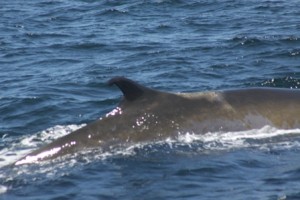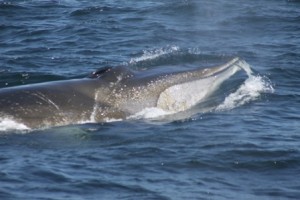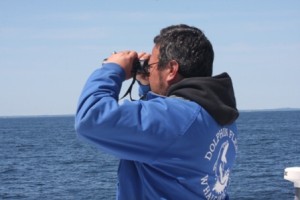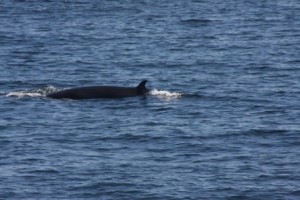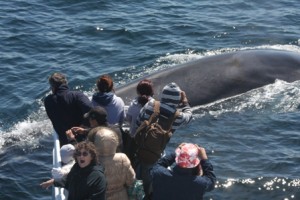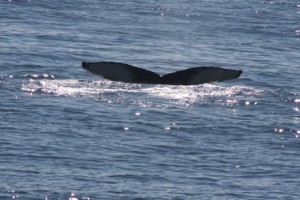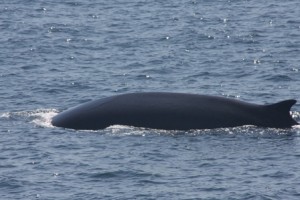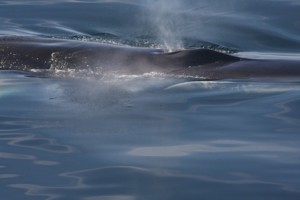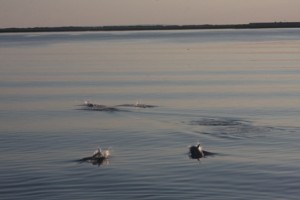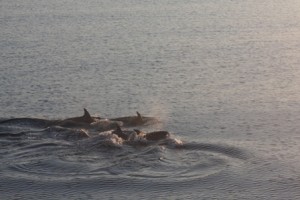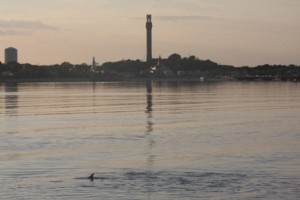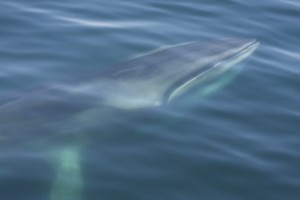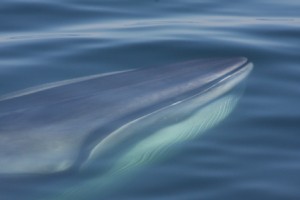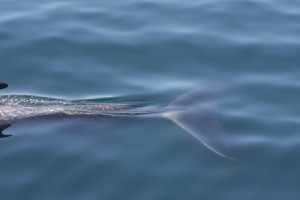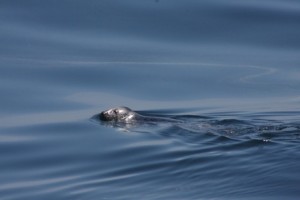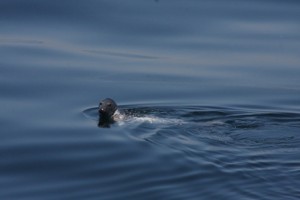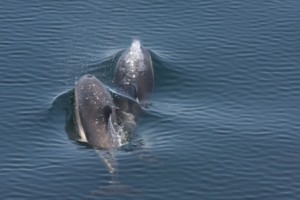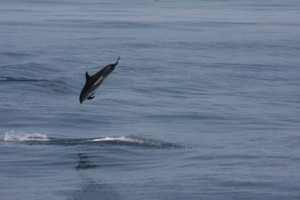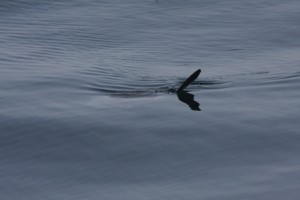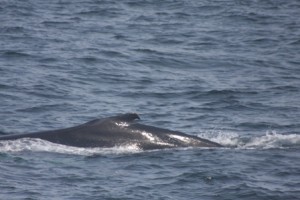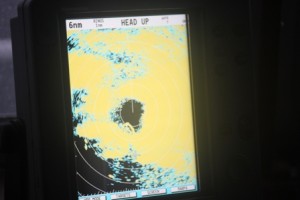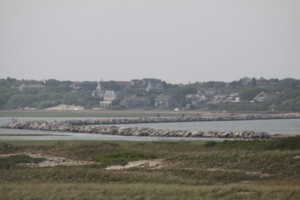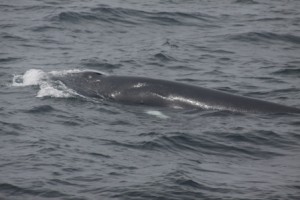Dolphin Fleet Naturalist Notebook – June 4 to June 10
We left Provincetown Harbor on June 4th and the action started immediately. Just as we were rounding Wood End, the second lighthouse on our way out of Cape Cod Bay, we came upon a medium sized pod of Atlantic white-sided dolphins. We estimated that the group was made up of approximately 50 – 75 individuals. As we continued northward, several of these dolphins could be seen surfing the wake of the boat!
By the time we reached Race Point, the northern tip of Provincetown, we had already honed in on a tall spout just a few miles off the beach. As we got closer, we found that it was Loon, one of our most ubiquitous fin whales. Loon’s distinct dorsal fin and loon shaped scar make this whale very easy to identify.
As Loon swam parallel to the boat, we got great looks at the asymmetrical coloration typical of fin whales. In the photo below, notice that the whale’s lower jaw is white. This coloration is on the right side of the body only.
On June 5th, we had to travel a bit further to see our first whale. We spotted our first fin whale just southwest of Stellwagen Bank. Stellwagen Bank is an underwater ledge located just north of Provincetown. The combination of underwater ledges and prevailing currents creates an ideal location for upwellings to occur. Upwellings mix and circulate nutrient-rich water from the ocean floor, creating a cascade of productivity.
After getting several excellent looks, we decided to go on a search to see if any other whales had arrived in the area. We traveled along the beaches of Provincetown and Truro until we got to the Highland Light area. Along the way, we noticed a bunch of baitfish making splashes at the surface — definitely a good sign as these are what whales like to eat!
Many Minke whales, including one that appeared to be feeding, could be seen in this area today. Minke whales are the smallest of the baleen whales that we see on our trips, but despite their diminutive appearance, they still measure in at 15 to 30 feet!
On our afternoon trip, we had phenomenal looks at a fin whale named Skeg. A skeg is the “fin” of a surfboard or the extension of a boat’s keel. The scientists who named this whale thought that Skeg’s dorsal fin resembled that fin-like extension. Skeg had clearly located some of the baitfish we had seen earlier on and did a powerful slow lunge through a school of these fish, fully extending the ventral pleats on the underside of its body. This happened a mere 10 feet from the boat!
After a day of fin whales, we were excited to get one fleeting look at a humpback whale, making it a three species day! Echo, a female first seen in 1988 made a brief appearance just as we were getting ready to head back to the dock.
Heading towards the Race on June 6th, we saw a big spout in the distance, and we expected it to be Loon, the fin whale that had posted up in that spot for days. Instead, we found another fin whale which was distinguishable by some thin propeller scars on its back.
The liveliness of the ocean continued to be evident as we headed beyond the Race to search beyond Peaked Hill. We passed through a school of bluefish teeming at the surface, as birds flew overhead. As we crossed the Truro line, we went by at least 10 to 15 gray seals, one of whom had a fish in its mouth! Minkes were also seen popping up intermittently.
As the seas calmed throughout the afternoon, our looks at fin whales improved tremendously. The calm waters allowed us full looks at these massive animals, as they swam parallel to the boat.
After a beautiful afternoon on the water, our trip was topped off by a small pod of Atlantic white-sided dolphins in Provincetown Harbor! As we slowly cruised back to the dock, we watched dolphins leaping and surfing in the sunset, with the Pilgrim Monument as a backdrop.
The calm, glassy seas persisted into June 7th and we headed out to Race Point where we thought we’d be able to find some fin whales. Sure enough, two fin whales were circling around the mouth of Cape Cod Bay. When fin whales feed, they often will make large circles to corral their food. This can make them challenging to follow, but luckily the calm seas made them easy to spot. In the photo below, you can see the ventral pleats on the underside of this whales body which expand when the whale takes in a mouthful of food.
People are often surprised by the actual length of fin whales. As the second largest animal in the world, they can reach lengths of up to 90 feet! Their narrow body shape, combined with the fact that we only can see about a third of their body at a time, makes their true size deceiving. On such a calm day, we can see their whole body sub-surface — even their flukes!
A few gray and harbor seals made quick appearances among these giant fin whales. Classified in the group Pinnipedia, meaning “fin foot” or “wing foot”, these aquatic carnivores can often be seen along our shorelines hunting for fish. With the schools of bluefish seen earlier this week, we were not surprised to see seals in our midst.
On June 8th we traveled far to the east into rolling, gentle swells and found a bunch of Atlantic white-sided dolphins spread out into small groups. Unlike their more solitary cousins, the baleen whales, dolphins and other types of toothed whales are more likely to travel in groups, or pods.
The extra calm waters also allowed us to spot a few more rare beasts. First, we noticed a small fin bobbing in the water. Not sure whether it was a shark or a mola mola, we made our way over. It was the latter. The mola mola, or ocean sunfish, is considered by some to be the largest type of zooplankton. Despite the fact that it can weigh several hundred pounds, it is still largely carried by the currents. In the photo below, it strikes its typical pose, dorsal fin slightly askew as it basks near the surface.
And then, we actually did see a shark — two in fact! A basking shark, which, like our recently-departed right whales feed on small planktonic crustaceans. Unlike the baleen whales, however, these animals have modified gill rakers in their mouths which capture plankton as they swim forward.
With the approaching rainstorms on June 9th, we squeezed in two trips before the weather got bad. Already, it was quite a changed scene from the previous days, with the winds starting to gust and the chop starting to build. We found a pair of fin whales in the regular spot — right at Race Point, and then headed east to see what else there was to see. We did find one lone little humpback right off the backside of the Cape. It never showed its flukes, so its identity remained a mystery.
As we returned to shore on the second trip, we could see the storm approaching over the radar.
We were glad to make it back to land before we got drenched!
On June 10th we stayed pretty close to shore, as the fin whales had moved closer to Race Point, with one even making an appearance near Wood End. We took an eastward turn to see what was out by Highland Light in Truro. We found a Minke whale, which we were actually able to follow for a bit. Minke whales are generally fast and elusive, but this one circled the boat several times, allowing us a great look at the characteristic white patches on its pectoral fins!






